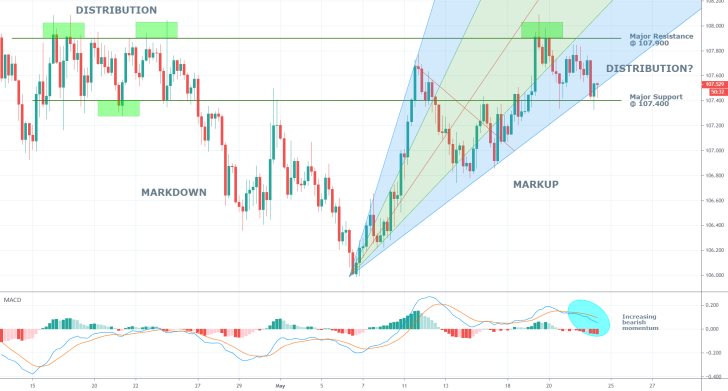
Earlier today, the Policy Board of the Bank of Japan decided to maintain the negative interest rate in the country unchanged at -0.10 per cent. This was vastly anticipated by the consensus forecasts and is the reason as to why there was no significant market shock following the publication of the decision.
Additionally, the Board announced that it would be continuing with its asset-purchasing programs to sustain sufficient levels of liquidity circulating within the broader financial system.
Arguably, the most important takeaway from the monetary policy decision was the disclosure that the Bank would continue purchasing Japanese government bonds (JGBs) without setting up an upper limit.
The Board stated that it anticipates the yields of most government treasuries to remain at around 0 per cent as a consequence of this extensive QE program.
The BOJ's decision to refrain from limiting the upper-boundary of its monetary policy underlines the significance of the coronavirus fallout that weighs heavily on the Japanese economy.
But even more so, it signifies the uncertainty that looms over the eventual path to economic recovery. The market can, therefore, interpret the BOJ's overwhelmingly accommodative policy as an indication of the Bank's preparations for mitigating further economic disruptions down the line.
At any rate, investors are likely going to stay away from the local bonds market, which is going to have indirect consequences for the Japanese yen.
The currency has been bolstered by heightened global demand during the COVID-19 pandemic due to its status as a safe-haven asset. However, BOJ's extensive asset-purchasing programs could offset this effect as investors and traders start fleeing to more competitive options.
The yen has been losing ground to the greenback over the last several days, and the aforementioned developments could bolster this process even more.
As can be seen from the 4H chart below, the USDJPY appears to be gearing up before it attempts to break out above the major resistance level at 107.900 yet again after three failed previous attempts.
The price action has tumbled to the pitchfan's lowest boundary, which is currently serving as an intermediate support. If it bounces back up from it, this is going to underline the strong bullish commitment in the market.
However, should the price action fall below the pirchfan's lowest boundary, but above the major support level at 107.400, this could potentially highlight the formation of a new Distribution range.
A potential consolidation of the price action between the major resistance and the major support levels could be interpreted as a transition from bullish trending environment into range-trading one, which, in turn, could be followed by the formation of a new bearish trend.

Trendsharks Premium
Gold is undergoing a correction, as investors take profits to offset losses from falling stock prices, impacting their margins. However, we anticipate a renewed wave of [...]
The Swiss stock market index is mirroring its global counterparts, such as Germany 40 and US100, experiencing a sharp decline following the announcement of new [...]
We’re analyzing the weekly chart to grasp the broader market trend. Over the past three years, the US30 index has surged by 17,000 points, often resembling a nearly straight [...]
Over the past week, the DAX has experienced a sharp decline, plunging by an astonishing 3,400 points. This downward movement is not isolated, as its international counterparts, such as the UK100 and US100, are also facing significant [...]
EURUSD recently formed a double top at 1.0930, signaling a potential trend reversal, and has since begun a correction. After a 600-pip rally since early March, a pullback at this stage is both expected and healthy. Given these conditions, we are placing a [...]
Since early March, EURJPY has surged nearly 1,000 pips, providing us with several excellent trading opportunities. However, as the rally matures, many early buyers are beginning to take profits, leading to a noticeable slowdown in the uptrend. On Friday, the pair formed a [...]
The AUDJPY currency pair continues to be dominated by bullish momentum, as multiple golden cross patterns reaffirm the strength of the ongoing uptrend. Despite this, we are witnessing a much-needed [...]
The EURAUD currency pair appears to be undergoing a trend reversal, signaling a potential shift in market direction. A notable technical development is the formation of a Death Cross on the chart, a widely recognized bearish indicator that typically suggests a [...]
After securing an impressive 200-pip profit last week, the EURJPY currency pair is now undergoing a southward correction, retracing some of its recent gains. Despite this temporary pullback, the Golden Cross remains intact, reinforcing our view that the overall trend continues to be [...]
The appearance of a Golden Cross in Silver strengthens our analysis that the metal is currently in a strong uptrend, indicating further bullish momentum in the market. This technical pattern, where the short-term moving average crosses above the [...]
This trade presents a considerable level of risk and can be classified as an opportunistic move based on recent price action. The GBPUSD currency pair has experienced a substantial bullish rally, surging by nearly 500 pips in a strong upward movement. However, after this extended period of appreciation, the pair is showing signs of a potential [...]
The anticipated Death Cross on the SMI20 appears to be failing as price finds strong support at the 23% Fibonacci retracement level. After testing this area, the index has shown bullish strength, printing several large green candles, signaling an increase in [...]
A Golden Cross has just appeared on the USDJPY chart, signaling a potential bullish move. This technical pattern occurs when the 20 period moving average crosses above the 60 period moving average, a widely recognized indication of increasing [...]
After 2 months of a down trend, we finally see some indications of price recovery for Oil. The golden cross, a historic buy signal, supports this [...]
For the past month, the German DAX40 has experienced a remarkable 10% surge, reflecting strong bullish momentum. Despite ongoing market volatility and frequent pullbacks, every dip continues to attract fresh buyers, reinforcing the [...]
Oil continues its downward trajectory, despite occasional pullbacks. The overall trend remains bearish, reinforced by multiple Death Cross patterns, a classic sell signal indicating further weakness. Adding to this bearish outlook, the critical [...]
Over the past few days, gold has experienced a sharp decline of more than $100. This downturn can be attributed in part to traders securing profits to manage their margins, which are under strain due to the significant drop in major indices. Currently, gold has fallen below the [...]
The NASDAQ 100 index is showing strong bullish momentum, as evidenced by the formation of a Golden Cross on the chart. This classic buy signal occurs when the short moving average crosses above the long term moving average, suggesting that upward momentum is [...]
The EURAUD currency pair has encountered a significant resistance level, failing to break above the critical 61% Fibonacci retracement level. This suggests that bullish momentum is weakening, reinforcing the case for a potential downward move. Given this technical setup, we favor entering a [...]
The UK100 is experiencing a remarkable rally! Over the past few weeks, the British stock market index has surged nearly 800 points. Each minor dip has attracted more buyers, fueling the bullish momentum. However, since last week, we’ve observed a slight [...]




















